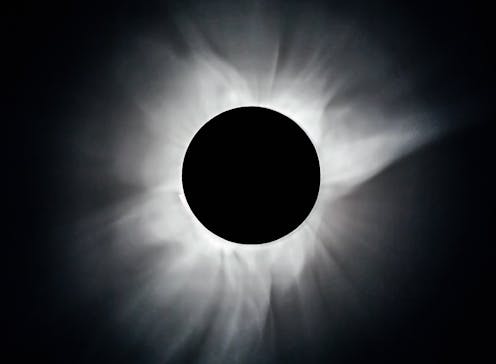The hunt for ‘planet nine’: why there could still be something massive at the edge of the Solar System
The Sun’s gravitational pull extends more than 160 times further into space than Neptune. Vadim Petrakov
Is there a massive undiscovered planet on the outer reaches of the Solar System? The idea has been around since before the discovery of Pluto in the 1930s. Labelled as planet X, prominent astronomers had put it forward as an explanation for Uranus’s orbit, which drifts from the path of orbital motion that physics would expect it to follow. The gravitational pull of an undiscovered planet, several times larger than Earth, was seen as a possible reason for the discrepancy.
That mystery was ultimately explained by a recalculation of Neptune’s mass in the 1990s, but then a new theory of a potential planet nine was put forward in 2016 by astronomers Konstantin Batygin and Mike Brown at Caltech (the California Institute of Technology).
Their theory relates to the Kuiper Belt, a giant belt of dwarf planets, asteroids and other matter that lies beyond Neptune (and includes Pluto). Many Kuiper Belt objects – also referred to as trans-Neptunian objects – have been discovered orbiting the Sun, but like Uranus they don’t do so in a continuous expected direction. Batygin and Brown argued that something with a large gravitational pull must be affecting their orbit, and proposed planet nine as a potential explanation.
This would be comparable to what happens with our own Moon. It orbits the Sun every 365.25 days, in line with what you would expect in view of their distance apart. However, the Earth’s gravitational pull is such that the Moon also orbits the planet every 27 days. From the point of view of an outside observer, the Moon moves in a spiralling motion as a result. Similarly, many objects in the Kuiper Belt show signs of their orbits being affected by more than just the Sun’s gravity.
While astronomers and space scientists were initially sceptical about the planet nine theory, there has been mounting evidence thanks to increasingly powerful observations that the orbits of trans-Neptunian objects are indeed erratic. As Brown said in 2024:
I think it is very unlikely that P9 does not exist. There are currently no other explanations for the effects that we see, nor for the myriad other P9-induced effects we see on the Solar System.
In 2018, for example, it was announced that there was a new candidate for a dwarf planet orbiting the Sun, known as 2017 OF201. This object measures around 700km across (Earth is roughly 18x bigger) and has a highly elliptical orbit. This lack of a roughly circular orbit around the Sun suggested either an impact early in its lifetime that put it on this path, or gravitational influence from planet nine.
Problems with the theory
On the other hand, if planet nine exists, why hasn’t anyone found it yet? Some astronomers question whether there’s enough orbital data from Kuiper objects to justify any conclusions about its existence, while alternative explanations get put forward for their motion, such as the effect of a ring of debris or the more fantastical idea of a small black hole.
The biggest issue, however, is that the outer Solar System just hasn’t been observed for long enough. For example, object 2017 OF201 has an orbital period of about 24,000 years. While an object’s orbital path around the Sun can be found in a short number of years, any gravitational effects probably need four to five orbits to notice any subtle changes.
New discoveries of objects in the Kuiper Belt have also presented challenges for the planet nine theory. The latest is known as 2023 KQ14, an object discovered by the Subaru telescope in Hawaii.
It is known as a “sednoid”, meaning it spends most of its time far away from the Sun, though within the vast area in which the Sun has a gravitational pull (this area lies some 5,000AU or astronomical units away, where 1AU is the distance from the Earth to the Sun). The object’s classification as a sednoid also means the gravitational influence of Neptune has little to no effect on it.
2023 KQ14’s closest approach to the Sun is around 71AU away, while its furthest point is about 433AU. By comparison, Neptune is about 30AU away from the Sun. This new object is another with a very elliptical orbit, but it is stabler than 2017 OF201, which suggests that no large planet, including a hypothetical planet nine, is significantly affecting its path. If planet nine exists, it would therefore perhaps have to be farther than 500AU away from the Sun.
The band of green objects beyond Neptune is the Kuiper Belt.
Wikimedia
To make matters worse for the planet nine theory, this is the fourth sednoid to be discovered. The other three also exhibit stable orbits, similarly suggesting that any planet nine would have to be very far away indeed.
Nonetheless, the possibility remains there could still be a massive planet affecting the orbits of bodies within the Kuiper Belt. But astronomers’ ability to find any such planet remains somewhat limited by the restrictions of even unmanned space travel. It would take 118 years for a spacecraft to travel far enough away to find it, based on estimates from the speed of Nasa’s New Horizons explorer.
This means we’ll have to continue to rely on ground- and space-based telescopes to detect anything. New asteroids and distant objects are being discovered all the time as our observing capabilities become more detailed, which should gradually shed more light on what might be out there. So watch this (very big) space, and let’s see what emerges in the coming years.
Get your news from actual experts, straight to your inbox. Sign up to our daily newsletter to receive all The Conversation UK’s latest coverage of news and research, from politics and business to the arts and sciences.
Ian Whittaker does not work for, consult, own shares in or receive funding from any company or organisation that would benefit from this article, and has disclosed no relevant affiliations beyond their academic appointment.


